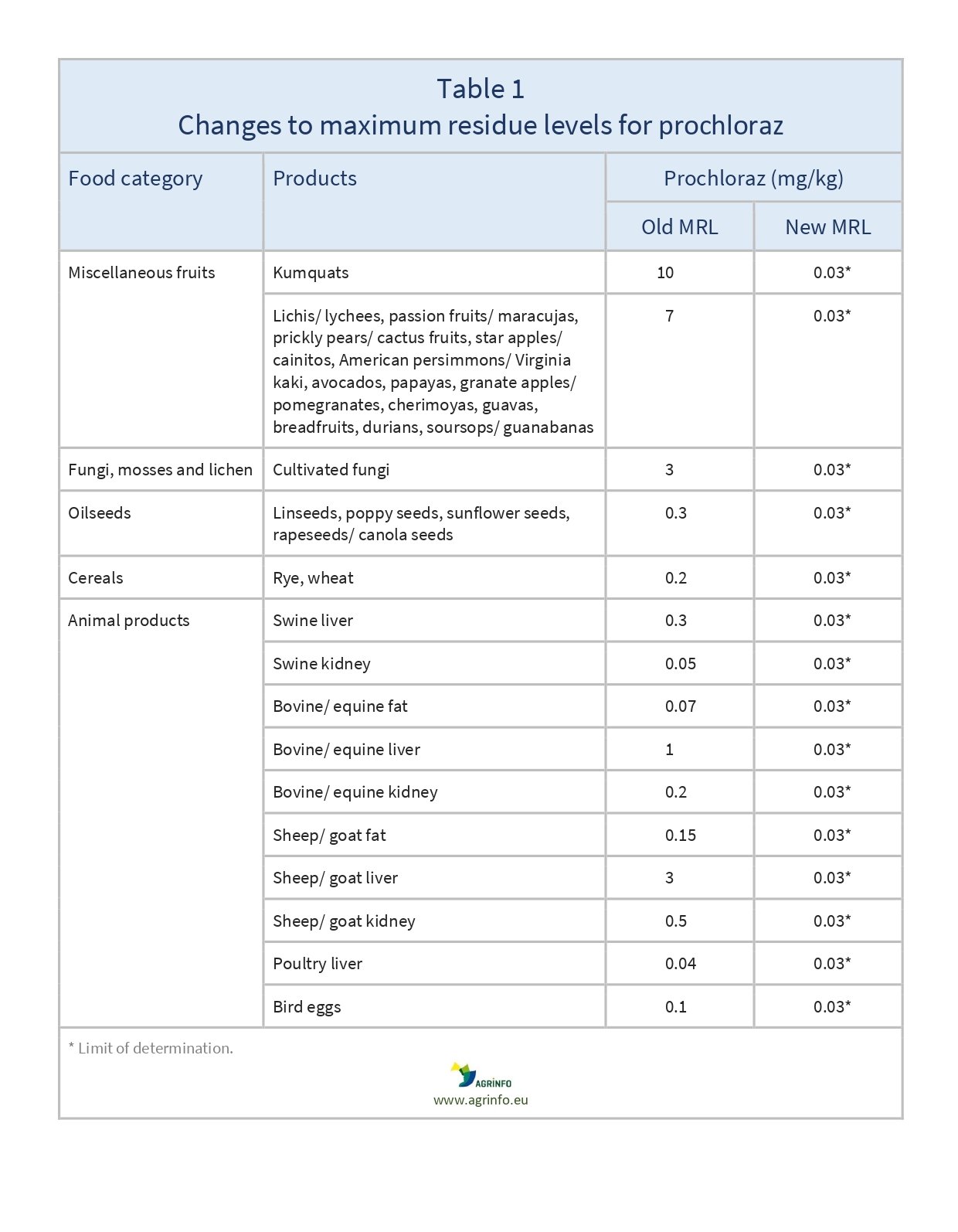Maximum residue levels for prochloraz
- Food safety
- Pesticide MRLs
Summary
The European Commission has reduced the maximum residue levels (MRLs) for prochloraz to the limit of determination (LOD), ranging from 0.03 to 0.15 mg/kg. (The LOD is the lowest level that can be detected using the most modern and reliable analytical methods.) There are implications for exporters of fruits, fungi, oilseeds, cereals, and animal products.
EU reduces MRLs for prochloraz to 0.03 mg/kg on all products, with impacts on certain fruits, fungi, oilseeds, cereals, and animal products.
Commission Regulation (EU) 2024/352 of 22 January 2024 amending Annexes II and V to Regulation (EC) No 396/2005 of the European Parliament and of the Council as regards maximum residue levels for (Z)-13-hexadecen-11-yn-1-yl acetate, (Z,Z,Z,Z)-7,13,16,19-docosatetraen-1-yl isobutyrate, acrinathrin, azimsulfuron, famoxadone, prochloraz and sodium hypochlorite in or on certain products
Update
The European Commission has reduced the maximum residue levels (MRLs) for prochloraz to the limit of determination (LOD), ranging from 0.03 to 0.15 mg/kg. (The LOD is the lowest level that can be detected using the most modern and reliable analytical methods.) There are implications for exporters of fruits, fungi, oilseeds, cereals, and animal products.
Impacted Products
kumquats, litchis/ lychees, passion fruits/ maracujas, prickly pears/ cactus fruits, star apples/ cainitos, American persimmons/ Virginia kaki, avocados, papayas, granate apples/ pomegranates, cherimoyas, guavas, breadfruits, durians, soursops/ guanabanas, cultivated fungi, linseeds, poppy seeds, sunflower seeds, rapeseeds/ canola seeds, rye, wheat, swine liver, swine kidney, bovine/ equine fat, bovine/ equine liver, bovine/ equine kidney, sheep/ goat fat, sheep/ goat liver, sheep/ goat kidney, poultry liver, bird eggs
What is changing?
The Commission has reduced the MRLs for prochloraz as summarised in Table 1.
Why?
Since 31 December 2021, prochloraz is no longer permitted for use in the EU.
When EFSA (2018) reviewed the MRLs for prochloraz, it changed its residue definition to “the sum of prochloraz, BTS 44595 (M201-04) and BTS 44596 (M201-03), expressed as prochloraz”. This is different from the residue definition set by Codex Alimentarius, on which the Codex MRLs (CXLs) are based. This new definition meant that additional data was needed, but this was not submitted. Because a risk to consumers cannot be excluded, the Commission has reduced all MRLs for prochloraz to the LOD.
Timeline
The new MRLs will apply from 12 August 2024.
Recommended Actions
Suppliers to the EU market of fruit, cultivated fungi, oilseeds, rye, wheat, and animal products should review their current use of prochloraz on these products and evaluate possible alternative solutions by August 2024.
Background
MRLs are set in accordance with the rules set out in Regulation 396/2005. For information on current MRLs for other substances, please consult the EU Pesticide Residues database.
Resources
EFSA (2018) Review of the existing maximum residue levels for prochloraz according to Article 12 of Regulation (EC) No 396/2020. EFSA Journal, 16(8): e05401.
Sources
Regulation 2024/352 as regards maximum residue levels for (Z)-13-hexadecen-11-yn-1-yl acetate, (Z,Z,Z,Z)-7,13,16,19-docosatetraen-1-yl isobutyrate, acrinathrin, azimsulfuron, famoxadone, prochloraz and sodium hypochlorite in or on certain products
Tables & Figures

Source: based on Regulation 2024/352
Disclaimer: Under no circumstances shall COLEAD be liable for any loss, damage, liability or expense incurred or suffered that is claimed to have resulted from the use of information available on this website or any link to external sites. The use of the website is at the user’s sole risk and responsibility. This information platform was created and maintained with the financial support of the European Union. Its contents do not, however, reflect the views of the European Union.
EU reduces MRLs for prochloraz to 0.03 mg/kg on all products, with impacts on certain fruits, fungi, oilseeds, cereals, and animal products.
Regulation 2024/352 as regards maximum residue levels for (Z)-13-hexadecen-11-yn-1-yl acetate, (Z,Z,Z,Z)-7,13,16,19-docosatetraen-1-yl isobutyrate, acrinathrin, azimsulfuron, famoxadone, prochloraz and sodium hypochlorite in or on certain products
What is changing and why?
The European Commission has reduced the maximum residue levels (MRLs) for prochloraz to the limit of determination (LOD). Since 31 December 2021, prochloraz is no longer permitted for use in the EU. (The LOD is the lowest level that can be detected using the most modern and reliable analytical methods.)
Actions
Suppliers to the EU market of fruit, cultivated fungi, oilseeds, rye, wheat, and animal products should review their current use of prochloraz on these products and evaluate possible alternative solutions by August 2024.
Timeline
The new MRLs will apply from 12 August 2024.
Tables & Figures

Source: based on Regulation 2024/352
Disclaimer: Under no circumstances shall COLEAD be liable for any loss, damage, liability or expense incurred or suffered that is claimed to have resulted from the use of information available on this website or any link to external sites. The use of the website is at the user’s sole risk and responsibility. This information platform was created and maintained with the financial support of the European Union. Its contents do not, however, reflect the views of the European Union.
